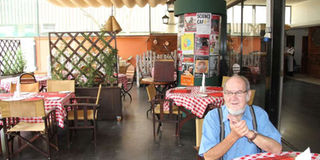Nostalgic trip on return of famous French chef

Christian at his La Belle Epoque in Nairobi. PHOTO | JOHN FOX
What you need to know:
- Loita and Monrovia Streets — are mainly where Elimo Njau first had his Paa ya Paa Art Gallery.
- The restaurant, at the back of the Alliance Francaise, is airy, looking out to a small garden with trees Christian planted himself in the 1970s.
- Our two dishes for sharing were Rognons au Vin Rouge — kidneys and mushrooms in a very rich red wine sauce.
French chef Christian Caldara is back at Alliance Francaise, Nairobi. He has opened La Belle Epoque in the same place where, in 1977, he opened Le Jardin du Paris. I went there with a friend, Raje, who knows far more about food than I do.
For both of us, it was a nostalgic trip. Raje remembers going to Le Jardin du Paris with his father, whose office was close by. When he looked at the chalked menu, he said, “Ah, Coq au Vin — that was my father’s favourite. We must try it today!”
Raje’s father will be back in Nairobi in a couple of weeks. I’m sure one of the first things Raje will do will be to take his father to La Belle Epoque — and for a long chat with Christian.
It was a nostalgic trip for me, too. Yes, we used to go there occasionally in the mid-1980s when we came back to Kenya to set up a consultancy. But my memories of that corner of the city — the corner of Loita and Monrovia Streets — are mainly where Elimo Njau first had his Paa ya Paa Art Gallery.
I was teaching at the University of Nairobi from 1967 to 1969, and Paa ya Paa — along with the Norfolk Terrace — was a favourite meeting place.
OPTIMISTIC PLACE
I guess I didn’t realise just how lucky I was to have conversations there with Elimo Njau, Ngugi wa Thiong’o (James Ngugi then) and Okot p’Bitek — Tanzania’s greatest artist, Kenya’s greatest novelist, and Uganda’ greatest poet. It was an exciting and optimistic place to be in those days.
But I mustn’t get lost down memory lanes...
Mind you, last Saturday lunchtime we wandered down quite a few memory lanes with Christian. It was a conversation that reconfirmed my view that for many, if not for all, of us life is a matter of hazard, chance encounters and unplanned happenings. For me, my first coming to Kenya was determined when my old professor at Nottingham University said one day in the common room in early 1967, “Would any of you young guys like to go to Kenya for a couple of years?” For Christian, it was a meeting on a London tube train with an American who persuaded him that Nairobi was a better choice of a place to work than cold Edinburgh, where he had intended to try his luck.
And the name that Christian has given his new restaurant also evokes a time past — the beautiful era, especially in Paris (1890 to 1914 and the outbreak of the First World War), known for an elegance in fashion, a flowering of art, and an appreciation of the “good things” of life.
PARIS STREET
The restaurant, at the back of the Alliance Francaise, is airy, looking out to a small garden with trees Christian planted himself in the 1970s, a few structures that evoke a Paris street — especially a traditional “colonne Morris” advertising column — and a machine that plays vinyl records.
After some excellent pork rillettes for starters and some very palatable house wine, Raje suggested we should share our two main courses in order to sample the menu. Fortunately, we had ample time for the food as well as the talk.
The menu reminded me of the classic French dishes that used to be on offer at the famous Alan Bobbe’s Bistro when it was on Koinange Street; for a time, Christian partnered with Alan Bobbe, and, when Alan died, Christian ran the Bistro on Riverside Drive and then at the Andrews Apartments at the end of Rhapta Road.
Our two dishes for sharing were Rognons au Vin Rouge — kidneys and mushrooms in a very rich red wine sauce — and, as insisted on by Raje, Coq au Vin — chicken braised with wine, lardons (small strips of pork), mushrooms, and garlic. Both dishes were very special. They were served with new potatoes and a mix of vegetables.
DESSERT
After all that — and after Raje talked about his father’s fondness for the Mousse au Chocolat — Christian made sure we shared that dessert, too.
We could see a storm was brewing, so we reluctantly declined the coffee that would have rounded off a splendid, and a rather indulgent, meal that was well in keeping with the name, La Belle Epoque.
After listening to Christian and Raje talk about food — talk with knowledge and passion — it made me think again about the wide difference between the northern and southern European countries, a difference about how they prepare, relish and take time over their food.
Is it something to do with the weather? The chilly East Anglia, where I grew up, was no place for the street cafés you find in the warmer countries of France, Italy and Spain. Or is it the Protestant work ethic of countries like Britain, Holland and Germany — having a conscience about spending so much time and socialising over your food?
John Fox is managing director of iDC





